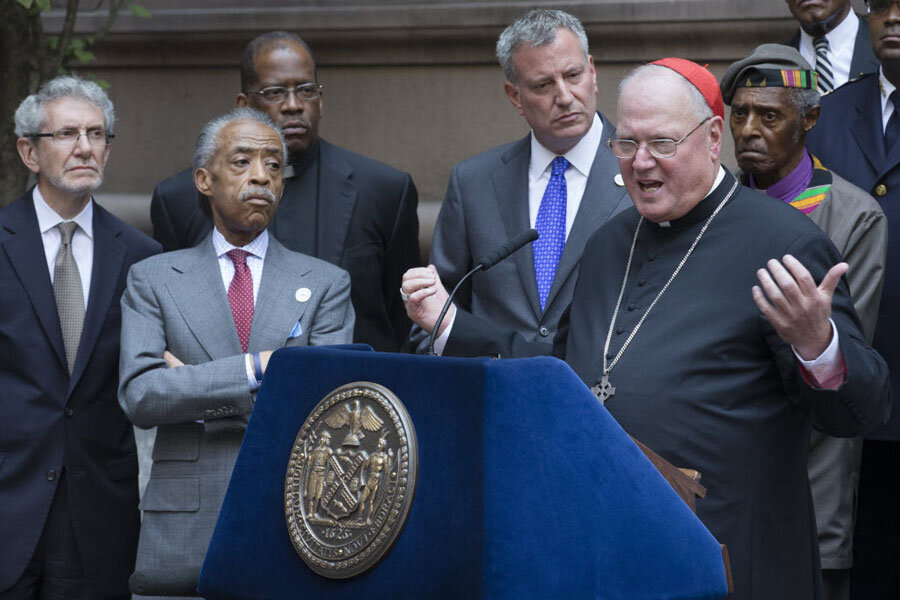Cardinal Timothy Dolan tries to make peace between NYPD and City Hall
Loading...
| New York
As tensions have begun to mount this weekend between the New York Police Department and the tens of thousands of protesters who continue to march against the grand jury decision in the killing of Eric Garner, the spiritual head of the area’s millions of Catholic residents spoke out on Monday, urging both sides “tune down the volume and speak calmly” as anger continues to rise.
And Cardinal Timothy Dolan, the charismatic archbishop of 2.6 million Catholics in much of New York City (Brooklyn and Queens are in a separate archdiocese with 1.6 million more Catholic residents), is in many ways in a unique position as a broker of peace in the city, remaining a highly respected religious official among the NYPD, which has traditions long shaped by the city’s Irish Catholic heritage.
This weekend, episodes of violence erupted in a few incidents across the city as some 30,000 protesters took to the streets, disrupting traffic and chanting slogans against the grand jury decision and the NYPD. And on Saturday night, a small breakaway group caused a disturbance on the Brooklyn Bridge, reportedly tossing materials onto the roadway below the pedestrian bridge and then assaulting two police lieutenants, leaving both hospitalized and one with a broken nose.
And members of the NYPD continued their verbal attacks against Mayor Bill de Blasio, who as a candidate was outspoken in his opposition to police tactics. Police appeared especially incensed over the past two weeks after Mayor de Blasio said he and his wife, Chirlane McCray, who is black, have told their biracial son Dante to be especially careful during encounters with police, citing a history of heightened dangers white children may not face.
On Friday, the Patrolman’s Benevolent Association, the NYPD’s largest union, responded by posting a form on its website for cops to sign, requesting that neither the mayor nor City Council Speaker Melissa Mark-Viverito attend his or her funeral, should they be killed in the line of duty.
Cardinal Dolan urged “upset leaders” not to pour “kerosene on the fire” and caricature “dedicated police officers as bigots.” And while he did not refer directly to any leader specifically, his words, published Monday in The New York Daily News, were linked to a story about the de Blasios’ worries about their son, and the vehement responses from NYPD officers and others.
But Dolan also denounced the union’s aggressive action against a hallowed public tradition.
“It is equally unfair and counterproductive to dismiss our mayor and other leaders as enemies of the police, and even to go so far as to make controversial one of the more gripping and tearful occasions in the life of this city, the funeral of a fallen officer, a sacred occasion meant to unite us, never fracture us.”
The cardinal, too, has played the role of peace broker before. After Garner was killed by police during an arrest for selling loose cigarettes in July, de Blasio outraged police by giving the Rev. Al Sharpton, a controversial civil rights activist, a prominent place in a forum about police and community relations.
The mayor asked Dolan to host a second meeting with the city’s spiritual leaders days before a major protest against Garner’s killing in August – a move that drew “kudos” from the NYPD at the time, who said the cardinal had respect and credibility among the rank and file.
But as protests continue, police frustration is beginning to show. For nearly two weeks, the NYPD has taken a mostly hands-off approach with protesters, allowing them to march amid traffic, and showing restraint when clearing episodes of peaceful disobedience -- a tactic shown by many police departments across the nation as marchers continue to protest the grand jury decisions in the cases of Mr. Garner and Michael Brown.
But after a number of reported injuries to police officers, who have been seen punched and taunted by some protesters, NYPD officials say it may be time to “draw the line,” even as the Mayor and other leaders denounce the violence over the weekend.
“Over the past few weeks we have gone to great lengths to ensure, even facilitate, people’s ability to protest,” said New York Chief of Department James O’Neill. “All during this time, our officers have shown extraordinary restraint and patience in the face of verbal abuse and much more ... But after tonight’s event, after our cops are assaulted, this is where we have to draw the line. I want to be clear that these assaults do not come with the territory.”
Despite the rising tensions, Dolan invoked the holidays to urge calm.
“This radiant season, when both Christians and Jews celebrate the triumph of light over darkness, life over death, and hope over despair, might be a providential time to rediscover our character, and that of this grand city, to tune down the volume and speak calmly,” he wrote.





